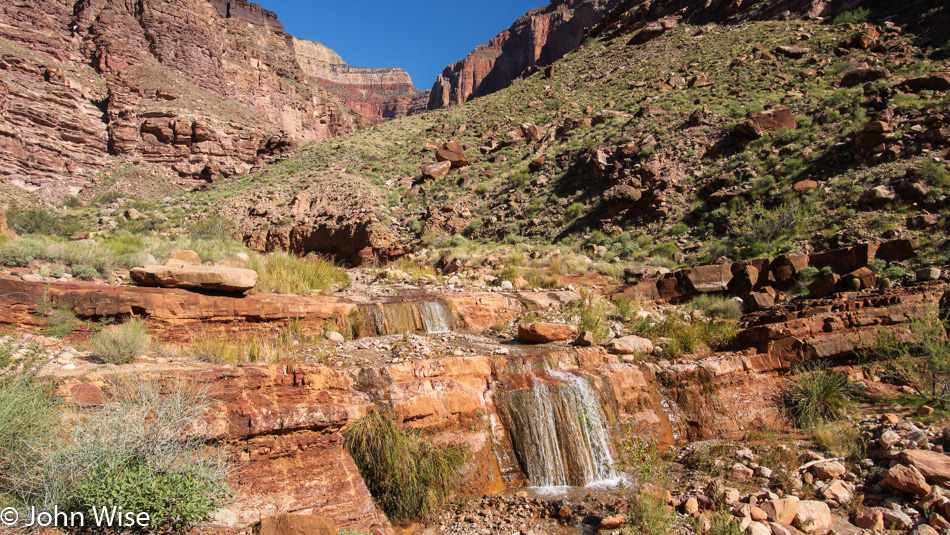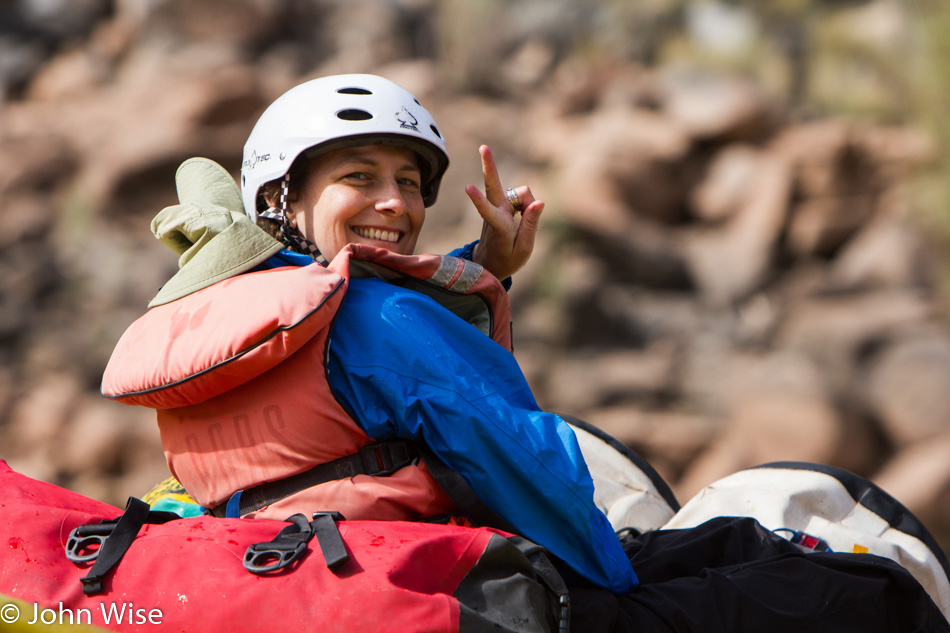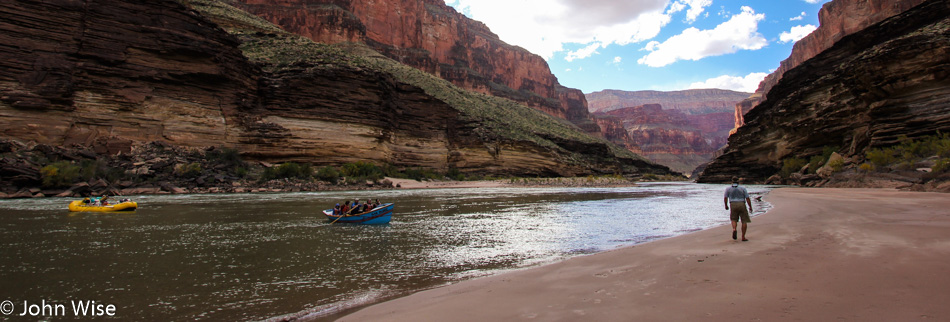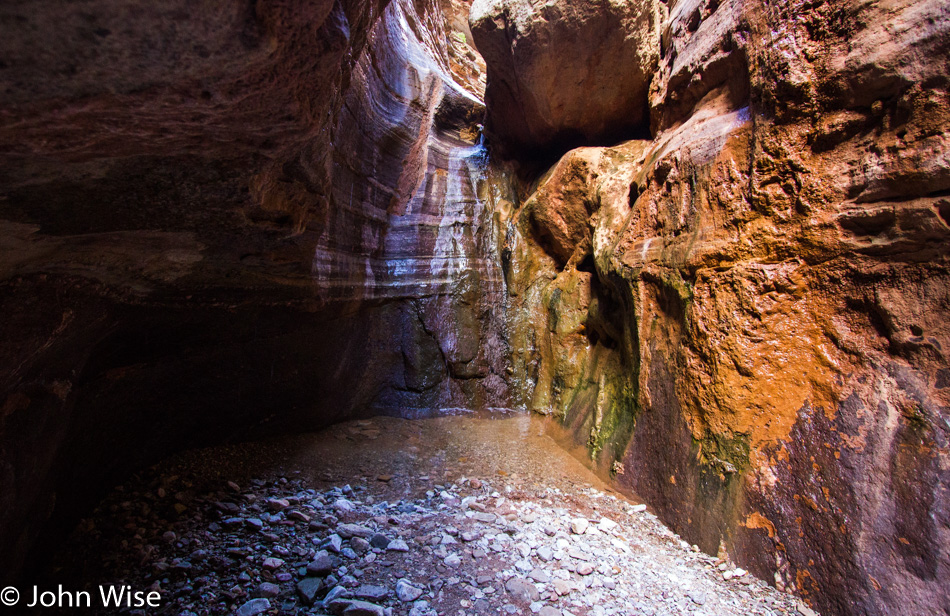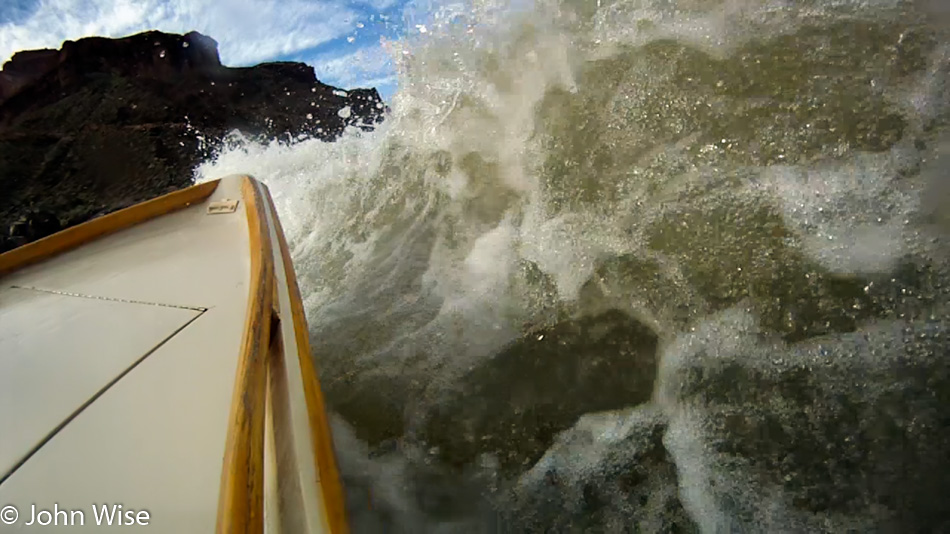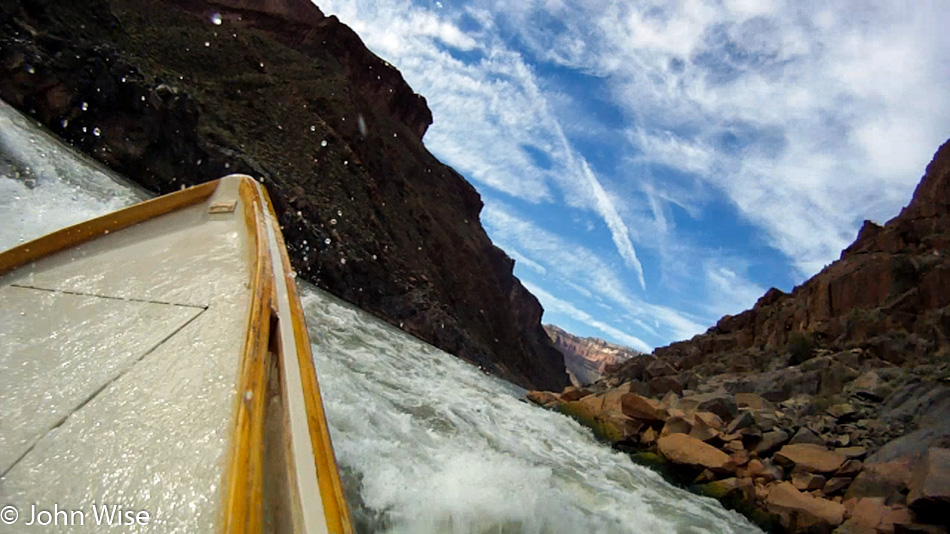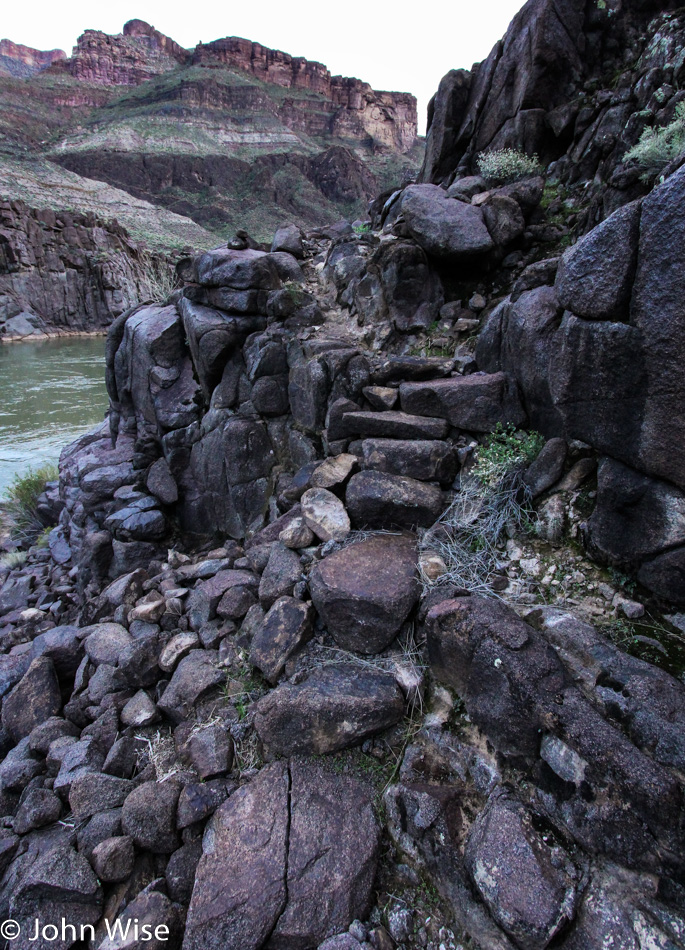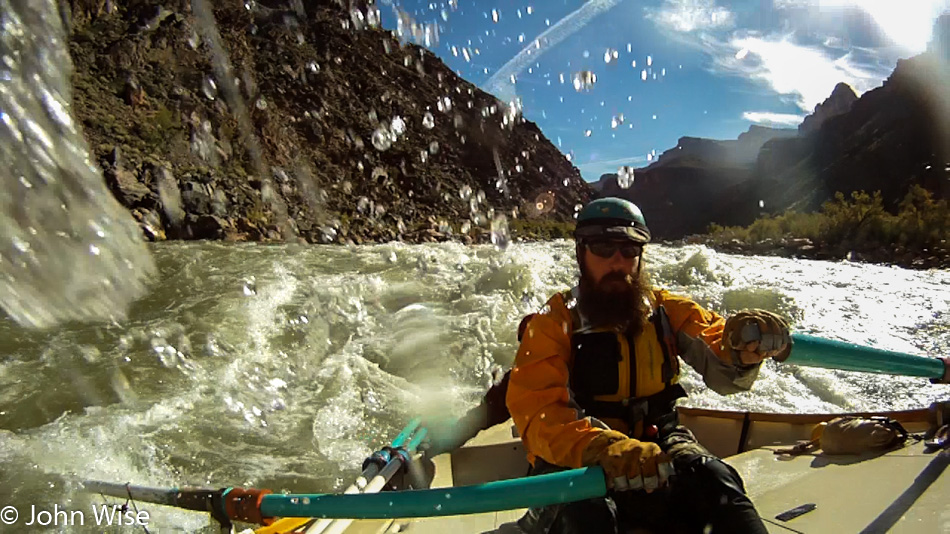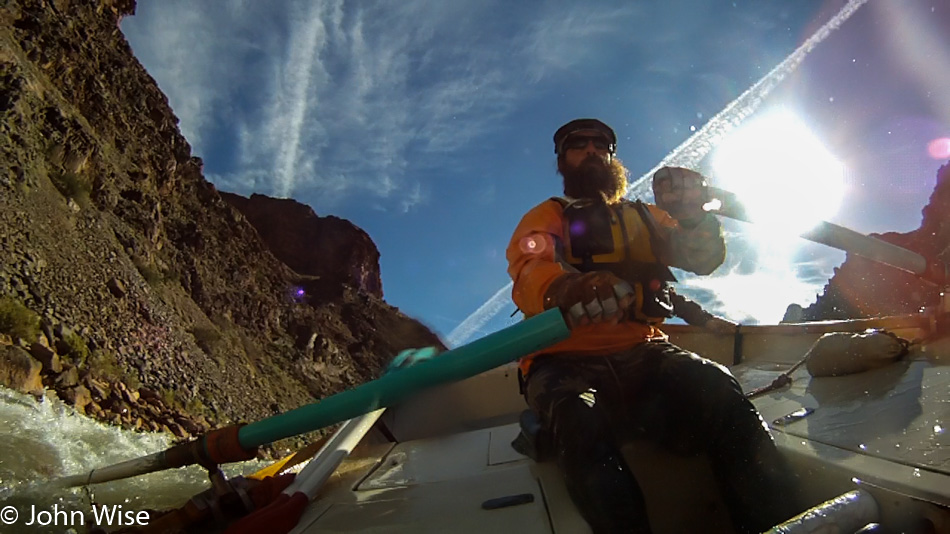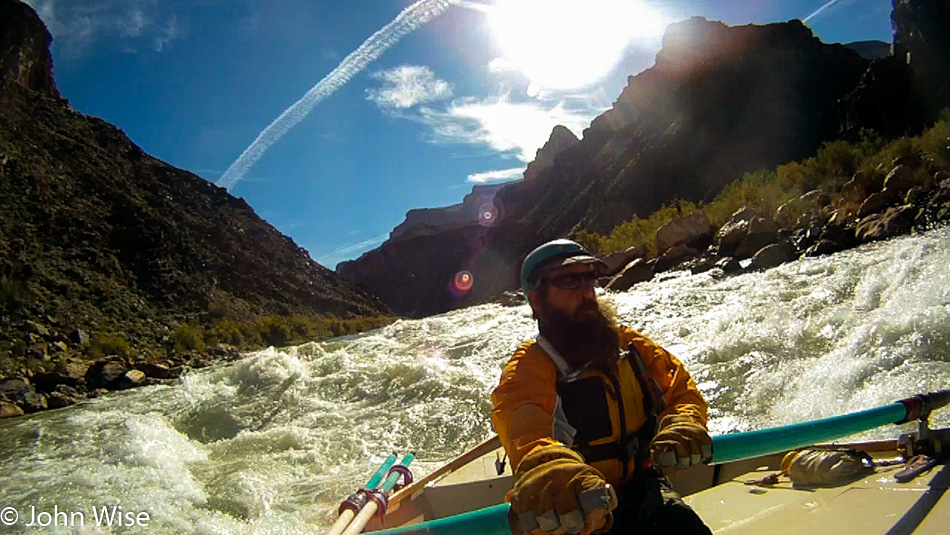
We wake to chaos. Who would have guessed that two days in the same camp would make us so comfortable that our home away from home would have time to fall into disarray? But this is just how the inside of our tent looks this morning – chaotic. Clothes that were hanging out to dry yesterday were tossed in late last night due to the boatmen’s prediction for a dewy night. Good thing we brought the laundry in because their read on the weather was spot on. Had we left the clothes outside, we would have had to pack them, still damp, into one of the gallon Ziploc bags we were told to use for our stuff in case of dry bag failure. Clouds stopped short of forming in our toasty tent while the dew painted the nylon walls with streamlets of moisture and speckled the ceiling with a smattering of water drops. Reluctantly returning to the routine of a quick clean-up and packing our gear, we bring the tent down and watch two days of fine-grain sand merge with enough water to make clay. No time to sweat the small stuff, though; we were told to be ready for an early exit from camp today.
After a quick breakfast of hot 9-grain cereal with dried cranberries and almonds offered as deluxe add-ins, we turn around to make a sack lunch, as today’s plan is to bring lunch with us on our hike. This is probably a good dieting routine – after getting my fill of breakfast, the sandwich I make is much smaller than if I were to make one at lunchtime, where my need to stave off hunger until dinner usually encourages me to stack my sandwich high with two of everything. Right after breakfast, I am still able to act responsibly and tread lightly on indulgence.


Initially, the plan was that the most robust hikers would take off on a difficult seven-mile trail that would consume the better part of the day. This type of hike requires one of the boatmen to accompany the overland travelers to our common destination four miles downstream. With one of our boatmen not available to row, one of the boats would need to be left on shore here at camp. Once those not out on the hike arrive at the rendezvous spot, two of the boatmen would have to hike back to retrieve the boat left onshore upstream. Remember that phrase, “Indecision is the key to flexibility?” Well, here it is being put to work; those plans are now no longer our plans. Late last night, the boatmen learned via the satellite phone (the same phone that is used in case of emergency to summon the dreaded air evacuation services) that the folks up at Glen Canyon Dam have decided to increase the flow of water from a steady 8,000 cubic feet per second to a peak of 16,000 CFS. Thus, it was determined that leaving a dory or a raft at Tapeats Creek was becoming too risky, as the rising water could easily unmoor the abandoned craft. To avoid losing one of our boats, the entire group leaves via the river.

On our way downstream, Jeffe, whose dory we are planted in today, notices a waterfall he had never seen before on river right. This catches me by surprise, as I had easily imagined these frequent fliers of the Colorado must have seen it all by now. Here is Jeffe on his 117th journey through the Grand Canyon, and he is seeing something new. I can comprehend how a man on foot would only see a tiny fraction of this Canyon, even after having walked a thousand miles or more, but Jeffe has rowed, floated, or otherwise traveled roughly 25,000 river miles on the relatively narrow waterway carved through this southwest corner of the Colorado Plateau. If by foot or by river, over many a year and an extraordinary number of miles, these old hands of the Canyon are still finding something new, I must accept that no one will ever know the entirety of the Grand Canyon.

When you realize that no one, not a solitary soul, will ever know all of this single National Park, how will any of us ever succeed in knowing much of anything at all about the planet we are living on? Yet people sitting in front of a television are content to act as armchair experts on subjects they may know little of outside of what that box of electronics has just told them. Our lack of meaningful real-world experience doesn’t stop us from forming maligned and uninformed gut feelings that we are allowed to vote on. How does one develop and mature a level of awareness about our natural world and how little we individuals truly understand or will ever know about it? My heart sinks at the thought that after billions of years of life’s progress we humans should wield so much power through ignorance.

Row, row, row your boat quickly down the stream. At lightning speed, we arrive at our trailhead, pulling up to shore to start the ascent up Deer Creek – mile 136.9. The dories and rafts are tied up high in anticipation that the river will be rising dramatically while we are up the creek. Next to the pull-in, not far from where we are about to start a scramble over some rather sharp and jagged rocks, is a gorgeous waterfall exiting a narrow slot high above us. The trail climbs steeply, giving us those views that in and of themselves would satisfy the cost of being here. Hand over foot, we climb what for me seems like a near-vertical ascent until reaching a shelf that will take us deeper into the side canyon.

The group story takes a pause here for me. The exposure, the sheer drop-off, and the loud rushing water, out of sight deep below, are too much for my occasional yet strong feelings of anxiety brought on by a fear of heights that isn’t always easily manipulated by my will. Just behind and below me right here, Deer Creek races on its way to the pour-over to become the waterfall that we admired down at the riverside. In my mind’s eye, I can see clearly how my 240-pound mass tumbles into the stream only to be spit out over the falls, to the shock of sunbathers below. Stunned, they might wonder out loud, “Just what the heck is that fat bearded guy doing?” before recognizing that I am not likely to survive landing on the rocks of the shallow pool I am accelerating towards. With the final scene of my internal movie over and my adrenaline pumping, I consider that this isn’t even the worst part of the trail – it gets narrower ahead. I ponder for two seconds what could be lost were I not to see what was up the canyon. The “Throne Room” sounds intriguing, and another spectacular waterfall is somewhere up there as well, but in what I hope is a wise decision, I opt to turn around now. For a second, I felt I could get over myself and press on; I’d done it before under other circumstances and was happier for my effort, but here and now, in this environment, I do not want to find myself on the other side of something that I might not be able to return from without insurmountable panic. So instead of putting the group, my wife, and myself into a situation where that satellite phone would have to summon a rescue operation, I suck up my predicament and turn to hike back down.
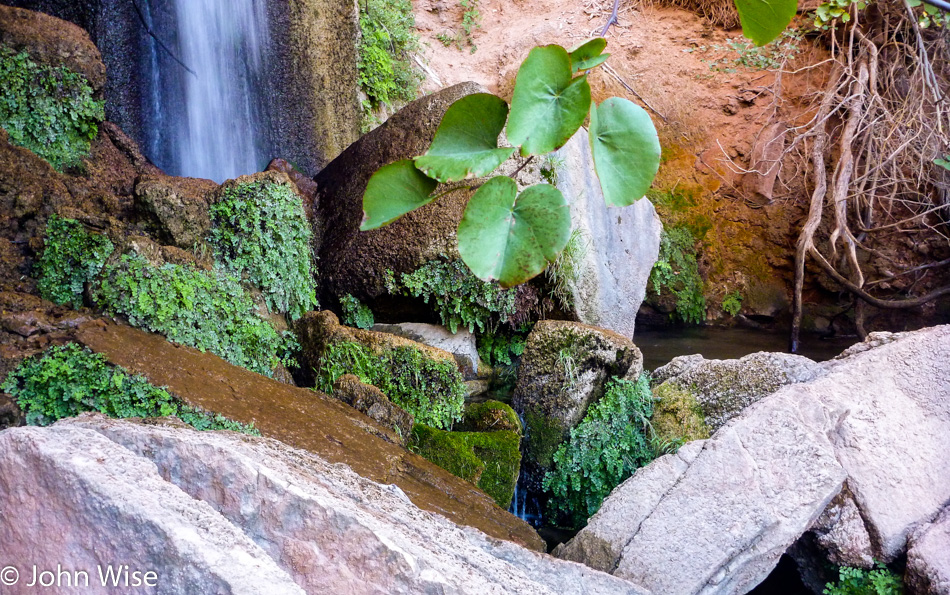
My wife graciously insists that she will return to shore with me. A little reassurance lets her know that I’ll be fine hanging out by the lower waterfall on my own and that she should go on to see this for the two of us. So here is Caroline’s impression of her time in Deer Creek Canyon as she related it to me later:
I continued on with the group bearing some apprehension myself about the width of the trail. They say that when couples are together long enough, they begin to take on the mannerisms and, to some extent, even some of the physical characteristics of their mate. For me, I have gradually picked up on John’s fear of heights – but nowhere to the extent, it affects him. If he thought the part of the trail where he left looked bad, I was happy he made the decision to turn around because further ahead, things got worse. A barely two-foot-wide ledge required us to scoot sideways, facing the cliff wall, gripping a thin rib of sandstone for stability while performing a daredevil crab walk. There were a couple of people who benefited from one of the boatmen offering a reassuring hand behind their back to steady them on this short section that felt inches wide. I focused on my hands holding the sandstone in front of me and kept taking tiny steps to the right. This part of the trail isn’t long and was crossed in just a few seconds, but you are right on the edge.
Beyond this big-time exposure, the trail opened up to the Patio. A group of boaters on their own trip were already hanging out here, giving me the feeling it was a little crowded. While some of our group stayed, I continued on with Bruce and First Light Frank. Leaving the narrows of the slot canyon, we walked into an expansive and lush green valley. I almost felt like we had left the Canyon and had fallen into Zion National Park. All of a sudden, we were surrounded by a dense forest of cattails taller than me, high grasses, cacti, a ton of flowers, and large cottonwood trees. To the side was a small campground. Our hike continued along the creek until we approached a sheer cliff wall where Deer Spring was gushing out of the rock face, producing a beautiful waterfall we were able to walk behind. On the sides of the waterfall grew a hanging garden of dripping plants, busy giving back the water they didn’t require. The view of the valley from behind the spilling liquid curtain was simply amazing. I wished John was with me to see it all with his own eyes since I knew that my camera would not be able to take in all of the details.
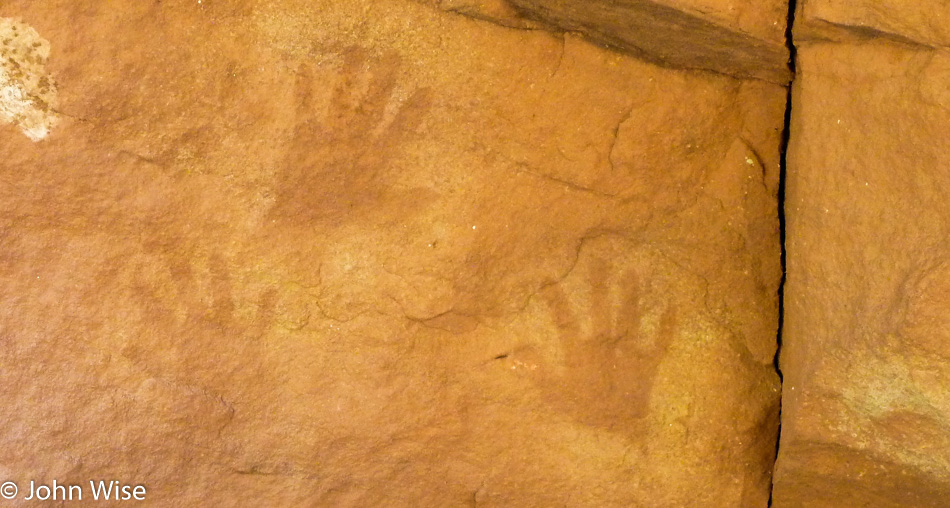
A few steps further up the trail, we arrived at the Throne Room, appropriately named, too. It must have taken years and the work of many visitors to rearrange the slabs of sandstone that have fallen from the crumbling cliffs surrounding us into massive chairs – thrones. Unlike at the Patio, we were here alone, taking up the seats of kings and queens before digging into lunch. Rondo and the rest of the group joined us a little later. Fellow passenger Erin and I left before the main group so that we could take photos of the greenery on the way back. This time, we crossed Deer Creek at the foot of the waterfall. Back at the Patio I sat down and had a drink, taking in how beautiful the soft lines of the well-worn sandstone had been massaged as Deer Creek sculpted this slot canyon. In some places, people can get into the water, and that’s just what Sarge did. A quick swim and we were on our way out to go find John.
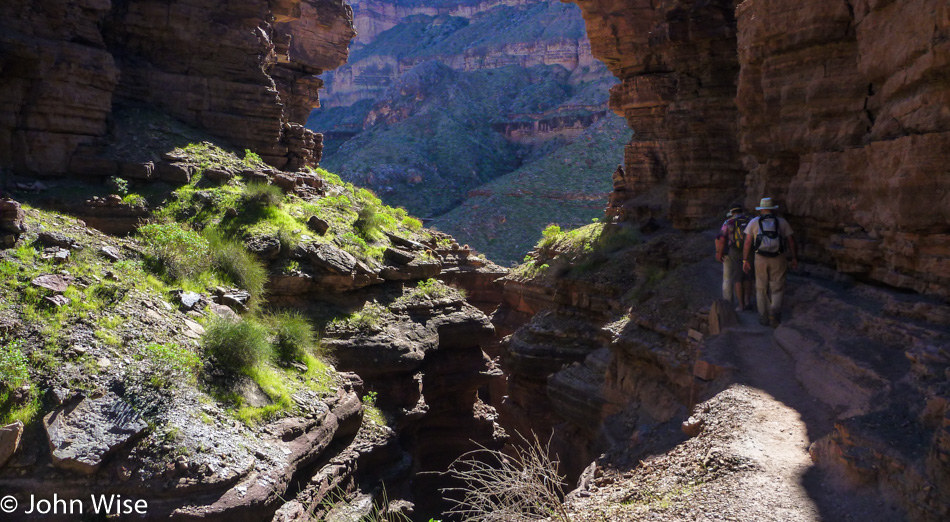
The way back to the river was scarier than the way in. Yes, it was the same path, but maybe it was the different angle from which we were looking at the trail. This is definitely not a hike for someone with a fear of heights or vertigo. Something I had not noticed on the way in was that on one of the walls right next to the trail was evidence that we modern visitors were not the first to see this incredible location: handprints, probably made using ochre, have remained here as a testament that the Ancestral Puebloans crossed over this very trail long ago. Emerging from the slot canyon, we walked past the spot where John had turned around earlier, and I could see him down by the dories, where it was obvious the river level had risen substantially. I tried signaling him; maybe it was the noise of the river or the crashing waterfall over his shoulder that stopped him from hearing my calls. Someday, I hope we’ll be able to hike into this area from a North Rim trail so he can see how beautiful this all was. Until then, he has my photos and my respect for having the presence of mind to do what was safest for him and the group, even if he did miss a little something. Now, back to John.

With Caroline and the group gone, I realize that I can’t help but feel some disappointment as my fears limit my potential. What am I being denied back there as I leave the shelf, half sulking inside, while the brave go on, and I drag myself back to shore? Better that I pull an old Monty Python tune out of the trunk of memories, dust it off, and give it a play, “Always look on the bright side of life….” It brings a smile to my face every time I think of it. I brush off the pity from my shoulder and start looking for what is going to make my visit to the lower fall of Deer Creek memorable.

I grab a chair and set myself down for some quiet observation, alone here at the river’s edge. Now, what is to be seen here that hadn’t been seen in great detail 30 minutes ago? Water, that’s the first thing. Out on the Colorado, undulating, flapping, splashing water, folding and collapsing as it sends atomized droplets skyward until gravity grips their trajectory, arcing them forward and then back down into the bigger flow they momentarily escaped from. There are no repeatable patterns or rhythms to the timing in which these waves collide with other water, or respond to sunken rocks buried from sight. They create successive dynamic forms, producing temporary artworks the futurists would be proud of.
At my feet, red ants scurry about, tending to business outside my purview of knowledge. Food gathering would be an obvious guess, but I’ll opt to dream of something not as mundane for these busy ants to be doing. But what might the story be? Impending attack on a Lilliputian scale to nab the 40-course human meal as the giant is lost in a daydream, staring at the hypnotic rush of water. Heck, maybe they are on a truly important mission to deliver the ring to Mordor. A giant black bumble bee zooms into the living tapestry being woven before my eyes. The bumbler’s ultimate role would remain veiled, as the ruse of searching for pollination opportunities was obviously transparent. With its cover on the verge of being blown and the dark overlord’s conquest in jeopardy, his death star body evacuates this sector.

Look out, here come the flies, stormtroopers of trash collection. Expendable mercenaries, every damn one of them. Pesky biological attack ships vomiting upon their dinner, doing the dirty work of the Empire. Out of batteries, my lightsaber would prove useless in combating the marauding invaders.
Jar-Jar the Lizard emerges from the deep, dark hole he had taken refuge in. He tries hard to earn my appreciation with his feeble attempts to snatch the stormtroopers from midair. I watch him as long as I can, but he fails to score even one direct hit; life imitates art. The flies continue with their dart-and-land combat techniques that do little besides finding my scorn. Watch out, Jar-Jar, and you stormtrooping winged pests, here comes the Millennium Falcon; okay, so it’s a canyon wren, but the force has obviously imbued this feathered hero, who perches atop the feeding chain, with great mysterious powers. Able to scoop up its enemies with a technologically advanced beak, the wren has no need for sidekicks or lightsabers.

With a snap, a wormhole opens in the space-time continuum, and the Starship Enterprise, disguised in dragonfly cloaking, breaks into my reality. It’s obviously on a reconnaissance mission to boldly go where no insect has gone before. For purposes only the captain on the bridge can know, the Starship Dragonfly darts left, right, back, and forward. With the flight recorder full of new details stored for a future mission, Scotty throws her into warp drive and exits the way she came in. Poof, they’re gone. In a blur, Sulu, Bones, Kirk, and Spock have left this galaxy and sadly neglected to beam me up.
As for the bees and butterflies down here on the river? They played no dramatic role this afternoon. They were on display to emphasize the sensual beauty of pollination and the dance of fluttering. The credits begin to crawl as I leave my seat to see what intrigues await me in the next theater.

The rise in the water level is becoming apparent as the beach is starting to disappear below the encroaching river. High in the sandstone above the tied-up dories, a hidden spring is feeding a seep that, in turn, supports a small hanging garden. A chalky film of salt stains the dark gray, almost black, desert varnish with a crystalline white layer, while streaks of greenish-black moss grow downward to the extent the dripping water is able to support its need for moisture. Around the seep, ferns and various other delicate plants cling to the wall.

Not far from the hanging garden, the red rock wall is barren and dry, although, on a small ledge further up, two prickly pear cacti have taken up the best seats in the house for watching the comings and goings of boats, passengers, wildlife, and the rise and fall of the river. Over to the far left, the Deer Creek waterfall maintains its constant pitch and hum on its way down to replenish the pool that acts as a collection basin. From there, it’s a short run before emptying into the Colorado, where its identity is lost in the bigger flow of water’s existence.
Since it is autumn, I can be happy that the sun finds itself low on the horizon instead of almost directly overhead. However, that doesn’t stop it from bearing down with no small reminder of its more sinister summer oppressiveness: it’s hot down here. In a few minutes, a towering summit on the opposite side of the Colorado will offer a shady break, preventing the sun’s rays from making direct contact with my pasty skin, which would not benefit from a desert varnish tanning. And then, right there, the sun goes out of view, and I’m here in the cool shade. Downriver, I can see the line temporarily separating the world of shadow from that of light. With the speed at which it travels my way, I surmise there might be 15 to 20 minutes of comfort left before putting on the squint again.
My solitude of self-imposed isolation comes to an abrupt end with the first trickle of the group returning to the river. I was certain I’d find boredom down here, but instead, the time flew by. I could have easily enjoyed a few more hours of doing nothing more than searching for that which requires idle moments of uninterrupted contemplation and imagination. Pardon me for not explicitly mentioning this yet, but the effect of the Canyon and these days on the river are producing a monumental reexamination of what’s what. My outlook, my look inward, and my place in the hierarchy of life and nature are being shifted. What these changes are precisely, I couldn’t have told you while still down there. Even months later, as I write these words, the magnitude of what has been altered hasn’t been fully appreciated yet.
There are hints of things that are different, such as how heartfelt my emotions have become as I look back at this and nearly any other venture into nature my wife and I have made. It is apparent that I may have taken much for granted. I can now see the fragility in a world too many of us are willing to erase, discount, pollute, and modernize. This idea of modernization cannot be reconciled with progress when it means we must destroy our natural world. For me, the interior of the Grand Canyon became a drug, and upon swallowing its pill, I turned into an overt tree hugger in nature’s matrix.

Time to fall out of the dream. Our group is once again complete, with each member accounted for. They stand amazed that the water level is up almost two feet, and the beach we landed upon is gone. I have no more time to linger; I will have to get back in the dory. This means that I will also be brought closer to the end of the day, the end of the week, and, eventually, the end of this journey. Unanswered mysteries are a more palatable solution to the big questions of life than the knowledge of the known endpoint. Even death will sneak up and happen on its own terms, while leaving the Colorado is a certainty just five and a half days away. Unless I figure out a way to bring it with me.

All Aboard! We’re going to ply a few more river miles down this warm, sunny corridor that is a million times better than any old thrill ride in a theme park, although I do still have a nostalgic love of those relics from my childhood. Maybe someday in the future, a potion will be found that digs into the recesses of my brain to find the many wonderful experiences I have had and forgotten, then amplifies them to beat up and subdue any of the negative ones that have managed to overstay their welcome. With the bad memories vanquished, I could fill the newly found space with more details kept from experiences such as what I am enjoying on this adventure. Today’s remaining miles are spent in blissful delight, floating under the warm sun, watching an ancient play of shadow puppetry on walls steeped in a familiar story of fleeting illumination, except that on this occasion, the performance seems to be for our benefit and our memories.
Camp Olo is the university dorm of campsites. We are nearly stacked one upon the other. If our group had two more people, we’d require two-story tents. The kitchen is set up in Erin and Jerry’s front yard and is put immediately to work in preparation for dinner. This is one of those nights in which the menu should be noted for its indulgent perfection. The appetizer is, of all things, a shrimp cocktail. Let me be clear: the shrimp are not made of dehydrated shrimp powder molded into shrimp-shaped tricks of the mind; they are previously frozen, freshly thawed, and ready for dipping into a bowl of cocktail sauce. The main course is spaghetti with pesto, shrimp scampi, garlic bread, and a fresh garden salad. These may seem like mundane details to a reader, but after nearly two weeks in the desert without a resupply, to be sitting here eating fresh food is the ultimate in luxury.
Tonight’s entertainment program consists of Jeffe reading from the book First Through Grand Canyon by Michael P. Ghiglieri, who shares details previously unreported about John Wesley Powell and his 1869 expedition, revealing surprisingly detailed journal entries and letters penned by other members of the group. The notes suggest Powell shouldn’t have taken all the credit and that historians may have been reluctant to set the story straight. Although it should be clear that he was the man who organized the now historic and important first run through the Grand Canyon, formal recognition should also be paid to J.C. Sumner, William Dunn, Seneca Howland, O.G. Howland, W. R. Hawkins, Andrew Hall, Frank Goodman, and John Wesley Powell’s brother Walter.
I wrote of bringing the Canyon and river with me when this adventure is over. I was afraid I would find myself drifting too far away from the details and emotions of these precious days after our return home. It would be the books we’ve been introduced to during the evening campfire sessions that played a big part in keeping those memories alive. To fill the gaps in the Canyon’s narrative, I searched for a contemporary who had taken one of these commercial river trips, who wasn’t in the canyon as a scientist, a super adventurer finding a new extreme method of riding the river, or some other professional who doesn’t connect with me on a personal level. I wanted to read about the average traveler who was swept up by the emotional impact found in the Canyon. While on one hand, those other stories are important too, the one book missing for me was the story of how one’s perspective and senses are reset and focused anew. I wanted to read of a person discovering their own profound emotional relationship to nature in the Canyon. To find those impressions of awe, I simply had to reflect upon my own memories and revisit the notes I kept during these days in the Canyon. With my thoughts ignited, my mind let the words flow onto the paper, allowing me to come back here to the Canyon, to be in these moments again and again.
–From my book titled: Stay In The Magic – A Voyage Into The Beauty Of The Grand Canyon about our journey down the Colorado back in late 2010.







